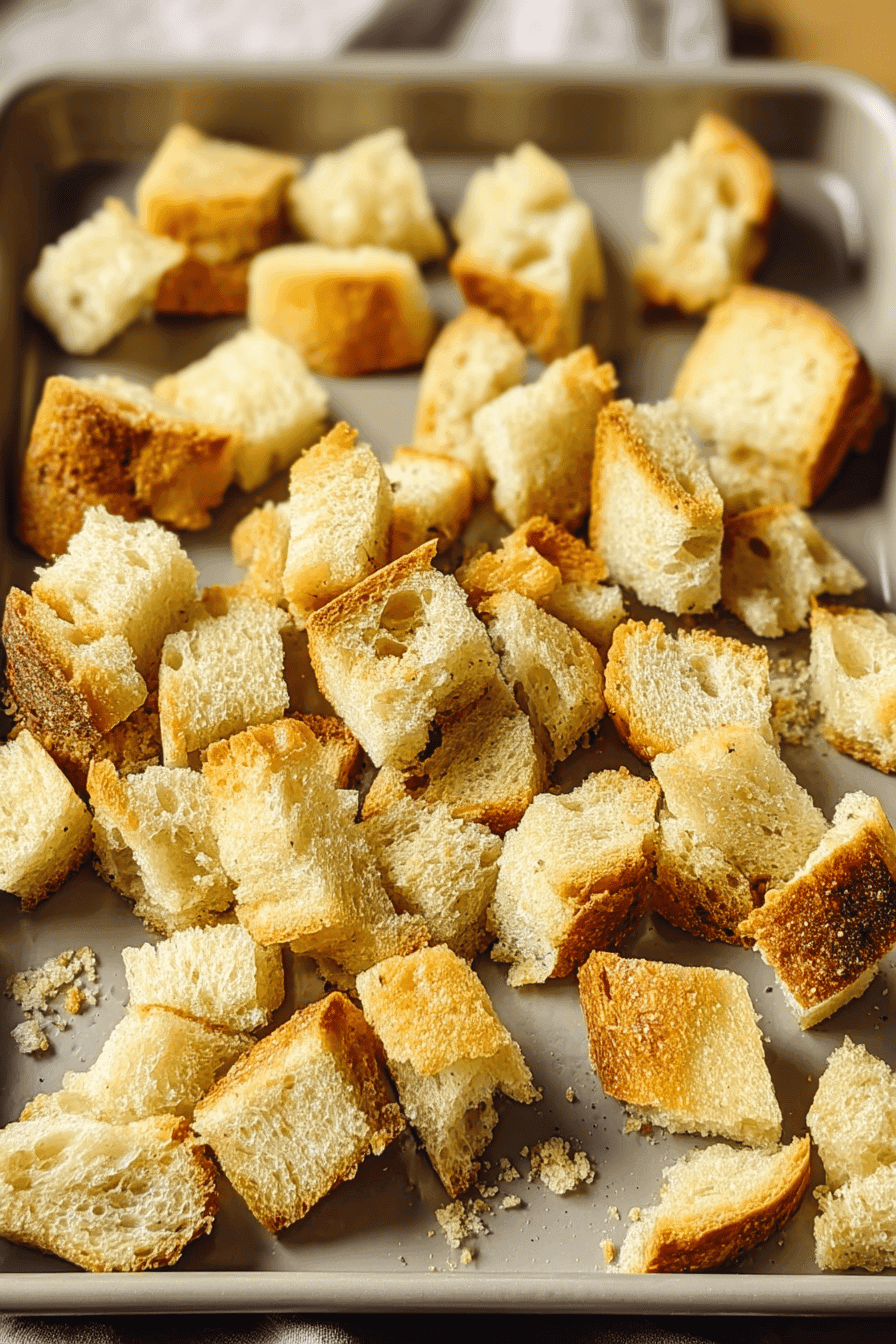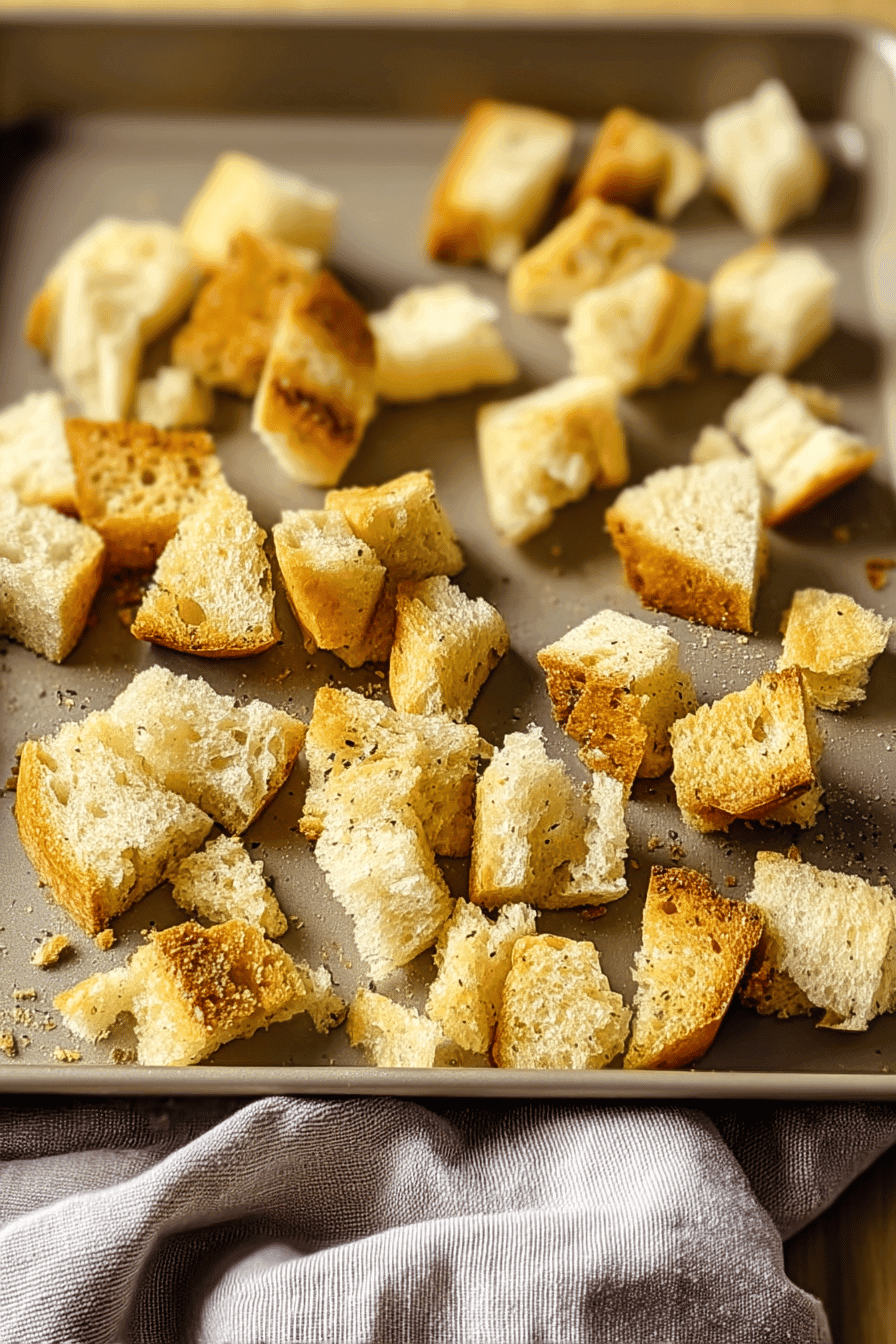Benefits and Advantages of Homemade Croutons
This homemade croutons recipe stands out for its simplicity, health advantages, and customizable flavor. Making croutons at home gives you control over the ingredients, ensuring freshness without preservatives often found in store-bought versions. The process is quick and easy, requiring just a few basic ingredients and minimal steps, making it ideal even for beginners.
From a health perspective, homemade croutons can be prepared with healthier fats and controlled amounts of salt, helping you avoid excess sodium and unhealthy additives. Using whole grain or gluten-free bread options increases dietary inclusiveness, making the recipe suitable for various nutrition needs. Plus, homemade croutons offer superior crunch and vibrant flavors, as you can customize seasonings with your favorite herbs and spices.
These flavorful, crispy croutons are perfect for upgrading salads, soups, or even snacking, adding satisfying texture and taste to everyday meals effortlessly.
Jump to:
- Benefits and Advantages of Homemade Croutons
- Essential Ingredients for Homemade Croutons
- Dietary Substitutions to Customize Your Homemade Croutons
- Gluten-Free Options
- Vegan Adaptations
- Low-Calorie Variations
- Sodium and Allergy Considerations
- How to Prepare the Perfect Homemade Croutons: Step-by-Step Guide
- Step 1: Preheat Your Oven
- Step 2: Cut the Bread
- Step 3: Prepare the Oil and Seasoning Mixture
- Step 4: Toss Bread Cubes
- Step 5: Arrange for Baking
- Step 6: Bake the Croutons
- Step 7: Cool and Store
- Mastering Homemade Croutons: Advanced Tips and Variations
- How to Store Homemade Croutons: Best Practices
- Nutritional Value of Homemade Croutons
- FAQs: Frequently Asked Questions About Homemade Croutons
- Can I use any type of bread to make homemade croutons?
- What ingredients do I need to make simple homemade croutons?
- How long and at what temperature should I bake croutons for the best texture?
- Can I freeze homemade croutons, and how should I store them?
- Are there alternative cooking methods for making croutons besides baking?
- Simple Steps to Make Crispy Homemade Croutons from Scratch
- Ingredients
- Instructions
- Last Step:
- Notes
- Nutrition
- Did you make this recipe?
Essential Ingredients for Homemade Croutons
To create delicious homemade croutons, you need a few key ingredients that provide structure, flavor, and the right crispiness:
- 1 loaf of bread (about 12 ounces or 340 grams), cut into 3/4-inch cubes or small chunks (about 4 to 8 cups depending on bread type)
- 1/4 cup (60 ml) olive oil or melted butter (or a combination like 1/3 cup olive oil and 3 tablespoons unsalted butter for richer flavor)
- 2 to 3 teaspoons Italian seasoning or a store-bought herbed seasoning blend
- 1 to 2 teaspoons garlic powder or 2 smashed/halved fresh garlic cloves (infused into oil for sharper flavor)
- 3/4 teaspoon fine sea salt
- 1/2 teaspoon freshly ground black pepper
- Optional: 1/4 cup grated Parmesan cheese
- Optional herbs for garnish or variations: dried parsley, oregano, dill, or rosemary
The choice of bread influences texture; sturdier crusty breads like French, Italian, sourdough, baguette, or gluten-free breads work especially well for consistent crunch. Olive oil offers health benefits and enhances flavor, but alternative oils like avocado or coconut oil work based on dietary preferences.

Dietary Substitutions to Customize Your Homemade Croutons
Customizing homemade croutons to suit various dietary needs is simple and flexible:
Gluten-Free Options
- Use certified gluten-free bread alternatives to maintain texture and flavor.
Vegan Adaptations
- Choose plant-based oils such as olive or avocado oil instead of butter.
- Select vegan bread free from eggs and dairy.
Low-Calorie Variations
- Use cooking spray or reduce oil quantity for a lighter coating.
- Opt for whole grain or low-carb breads to lower carbohydrate intake.
Sodium and Allergy Considerations
- Reduce or replace salt with herbs like rosemary or basil for flavor without sodium.
- Avoid nut-based oils or toppings if allergic.
These substitutions keep homemade croutons accessible and enjoyable for a broad spectrum of dietary needs, without sacrificing texture, flavor, or quality.
How to Prepare the Perfect Homemade Croutons: Step-by-Step Guide
Step 1: Preheat Your Oven
Set your oven to 375°F (190°C) for consistent, even cooking.
Step 2: Cut the Bread
Slice or tear the bread into uniform 3/4-inch cubes to ensure even baking and consistent texture.
Step 3: Prepare the Oil and Seasoning Mixture
If using fresh garlic, gently warm olive oil with smashed garlic cloves until fragrant, then discard cloves. Alternatively, combine olive oil (and butter if using) with garlic powder, Italian seasoning, salt, and pepper in a bowl.
Step 4: Toss Bread Cubes
Drizzle the oil and seasoning mix evenly over the bread cubes. Toss gently but thoroughly to coat each piece with oil and spices evenly. Add Parmesan cheese if desired and stir to combine.
Step 5: Arrange for Baking
Spread the coated bread cubes in a single layer on a parchment-lined baking sheet. Give them space to allow crisping rather than steaming.
Step 6: Bake the Croutons
Bake for 15-20 minutes, turning once halfway through to brown all sides evenly. Watch carefully to prevent over-browning; adjust baking time based on desired crunchiness. Lower oven temperature if croutons brown too fast.
Step 7: Cool and Store
Remove croutons from oven and allow them to cool completely on the baking sheet, which helps them crisp further. Store cooled croutons in an airtight container at room temperature for up to one week or freeze for longer preservation.
“Uniform bread cubes and even coating are the secrets to crispy, flavorful croutons that enhance any dish.”

Mastering Homemade Croutons: Advanced Tips and Variations
For the best homemade croutons, start with day-old bread as it toasts better and avoids sogginess. Before applying oil and seasoning, lightly toast bread cubes in a dry pan or oven to improve crunch. Experiment with seasoning blends like smoked paprika for a subtle smokiness, nutritional yeast to add a cheesy depth without dairy, or chili flakes for gentle heat.
Sweet croutons are a wonderful variation: toss your bread cubes with cinnamon sugar before baking for a dessert-like snack. Adding seeds like sesame or chia imparts extra crunch and boosts nutritional value. Adjust your baking time based on the bread’s density denser breads may need a few extra minutes to crisp but watch carefully to avoid burning. These creative adjustments make homemade croutons versatile, ideal not only for salads and soups but also for season-packed snacks or garnishes.
“Mastering seasoning and texture transforms homemade croutons from simple toppings to impressive flavor enhancers.”
How to Store Homemade Croutons: Best Practices
To keep homemade croutons crisp and flavorful, store them in an airtight container at room temperature, where they remain fresh for up to one week. Avoid refrigeration, which introduces moisture and leads to sogginess. For longer storage, freeze the croutons in a sealed freezer-safe bag or container for up to three months.
When ready to use frozen croutons, reheat them in a preheated oven at 350°F (175°C) for 5-8 minutes to restore crispness. This simple reheating prevents moisture accumulation that can soften the croutons. Following these steps guarantees you enjoy that fresh crunch and flavor whenever you add them to your dishes.
Nutritional Value of Homemade Croutons
Homemade croutons provide energy-rich carbohydrates from bread and healthy fats from olive oil or chosen cooking fats. Their nutritional profile can be managed through ingredient choices:
| Nutrient | Typical Amount (per 1/4 cup serving) | Notes |
|---|---|---|
| Calories | 80-120 kcal | Depends on bread type and oil used |
| Carbohydrates | 12-15 g | Mainly from bread, provides quick energy |
| Fat | 4-7 g | Healthy fats if olive oil is used; fat content adjustable |
| Protein | 1-3 g | Varies with bread type; whole grain offers more protein |
| Fiber | 1-2 g | Whole grain or gluten-free breads provide better fiber content |
| Sodium | 60-150 mg | Adjustable by seasoning amounts |
Choosing whole grain or gluten-free bread bolsters fiber intake, while using oils like olive or avocado oil adds beneficial monounsaturated fats. Reducing added salt and using herbs for flavor can lower sodium content. This customization supports health-conscious meals without sacrificing the croutons’ signature crunch and flavor.

FAQs: Frequently Asked Questions About Homemade Croutons
Can I use any type of bread to make homemade croutons?
What ingredients do I need to make simple homemade croutons?
How long and at what temperature should I bake croutons for the best texture?
Can I freeze homemade croutons, and how should I store them?
Are there alternative cooking methods for making croutons besides baking?

Simple Steps to Make Crispy Homemade Croutons from Scratch
🥖 Transform any leftover bread into crispy, golden croutons in no time!
👌 Elevate your salads and soups with these savory, crunchy toppings made right at home.
- Total Time: 25 to 30 minutes
- Yield: 4 to 8 cups of croutons 1x
Ingredients
1 loaf of bread (about 12 ounces or 340 grams), cut into 3/4-inch cubes or torn into small chunks (about 4 to 8 cups depending on bread type)
1/4 cup (60 ml) olive oil or melted butter (or a combination, e.g., 1/3 cup olive oil and 3 tablespoons unsalted butter for extra richness)
2 to 3 teaspoons Italian seasoning or a store-bought herbed seasoning blend
1 to 2 teaspoons garlic powder or 2 smashed/halved fresh garlic cloves (oil infused with garlic for a sharper flavor)
3/4 teaspoon fine sea salt
1/2 teaspoon freshly ground black pepper
Optional: 1/4 cup grated Parmesan cheese
Optional herbs for garnish or variation: dried parsley, oregano, dill, or rosemary
Instructions
1. Preheat oven to 375°F (190°C) and line a baking sheet with parchment paper.
2. Prepare bread by cutting or tearing into uniform 3/4-inch cubes or bite-sized pieces.
3. If using fresh garlic, gently heat olive oil and garlic cloves in a small saucepan over low heat until aromatic (about 1 minute), then discard garlic. Otherwise, combine olive oil (and butter if using) with Italian seasoning, garlic powder, salt, and pepper in a bowl.
4. Drizzle the oil mixture evenly over the bread cubes and toss gently to coat all pieces thoroughly. Add Parmesan cheese if desired and mix well.
5. Spread the bread cubes in a single layer on the prepared baking sheet.
6. Bake for 15 to 20 minutes, turning once halfway through to brown all sides, or until golden and crispy with slightly soft centers if preferred. Adjust baking time for desired crunchiness and watch carefully to prevent burning; reduce oven temperature if browning too quickly.
7. Remove from oven and let cool completely on the baking sheet to allow croutons to crisp further.
Last Step:
Please leave a rating and comment letting us know how you liked this recipe! This helps our business to thrive and continue providing free, high-quality recipes for you.Notes
🍞 Use any variety of bread: crusty French, Italian, sourdough, baguette, country bread, or gluten-free options work well. Day-old bread provides better texture than very fresh or too stale bread.
🌿 Seasonings can be customized based on preference—try blackening seasoning, fresh herbs, or different dried herbs like basil or rosemary.
🔥 For a smoky flavor, grill whole bread slices brushed with olive oil, then rub with garlic before cutting into cubes.
- Prep Time: 5 to 10 minutes
- Cook Time: 15 to 20 minutes
- Category: Snack, Side
- Method: Baking
- Cuisine: Universal
- Diet: Vegetarian
Nutrition
- Serving Size: 1 cup
- Calories: 120
- Sugar: 1g
- Sodium: 230mg
- Fat: 7g
- Saturated Fat: 2g
- Unsaturated Fat: 5g
- Trans Fat: 0g
- Carbohydrates: 14g
- Fiber: 1g
- Protein: 3g
- Cholesterol: 5mg







